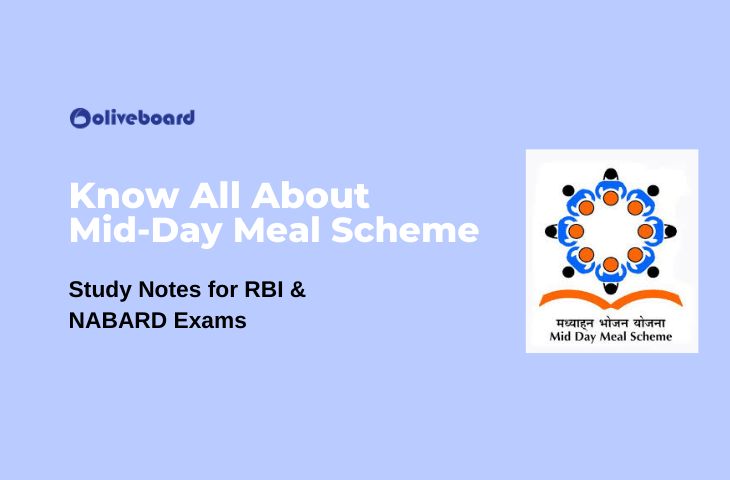The preparation for the Economic & Social Issues (ESI) paper of RBI & NABARD exams is incomplete without the preparation for the Government Schemes. Questions from the latest government schemes as well as some important old schemes are frequently asked in these exams. Therefore here in this blog, we are covering an important scheme by the name Mid-Day Meal Scheme. You must have definitely heard or read about this scheme. Let us go on and know all about this scheme.
I. Know All About Mid-Day Meal Scheme – ESI Notes
The Midday Meal Scheme comes under the HRD Ministry’s Department of School Education and Literacy. It is a centrally sponsored scheme. It was Launched in the year 1995 under the name of ‘National Programme of Nutritional Support to Primary Education (NP-NSPE)’.
» Know More about Mid-day Meal Scheme
- In October 2007, NP-NSPE was renamed as ‘National Programme of Mid Day Meal in Schools,’ which is popularly known as the Mid-Day Meal Scheme.
- Under the above scheme, every child within the age group of six to fourteen years studying in classes I to VIII who enrols and attends the school shall be provided hot cooked meal having nutritional standards of 450 calories and 12 gm of protein for primary (I- V class) and 700 calories and 20 gm protein for upper primary (VI-VIII class), free of charge every day except on school holidays.
- The scheme covers all government and government-aided schools and also Madarsa and Maqtabs supported under the Sarva Shiksha Abhiyan (SSA).
- It is considered the world’s largest school feeding programme aimed to attain the goal of universalization of primary education.
- The Ministry of Education has approved the proposal to provide monetary assistance to students through Direct Benefit Transfer (DBT) of the cooking cost component of the Mid-Day-Meal (MDM) Scheme, to all eligible children.
- The central government will provide additional funds of about Rs. 1200 crore to state governments and UT administrations for this purpose.
» Objectives of the Mid-day Meal Scheme
- To increase the enrolment in the schools of the children who belong to disadvantaged sections of the society.
- To increase the attendance of the children in government and government-aided schools.
- To retain the children studying in class I to VIII.
- To give nutritional support to the children studying in the elementary stage, especially in the drought-affected areas.
- To address hunger and malnutrition and improve socialisation among castes.
» Features Of Mid-Day Meal Scheme
- Every school should have a hygienic cooking infrastructure for hygienically cooked mid-day meals.
- The mid-day meals are to be served only on the school premises on all working days of the school.
- The headmaster or headmistress is entitled to utilise the school funds on account of mid-day meal fund exhaustion. However, the same will be reimbursed to the mid-day meal fund as soon as the school is credited with the same.
- Quality items with AGMARK are procured for cooking the mid-day meals in the schools.
- Two or three adult members taste the cooked meals from the school management committee.
- The Food and Drugs Administration Department of the State can collect samples for ensuring the quality and nutritional value of the meals.
- The State Steering-cum Monitoring Committee (SSMC) will oversee the implementation of this scheme, including establishing a mechanism to maintain the quality and nutritional standards of the meals.
- Food allowance is provided to the children when the cooked meals cannot be provided because of unforeseen circumstances in the following manner:
- Quantity of the food grains according to the entitlement of a child, and
- Cooking cost prevailing in the respective state.
- Quantity of the food grains according to the entitlement of a child, and
» Meals Provided Under The Mid-Day Meal Scheme
The quantity of food items provided under this scheme per child per school day is as follows:
|
Food items | Primary level (Class I-V) |
Upper level (Class VI-VIII) |
| Food Grains | 100 gms | 150 gms |
| Pulses | 20 gms | 30 gms |
| Vegetables (leafy also) | 50 gms | 75 gms |
| Oil & fat | 5 gms | 7.5 gms |
| Salt & condiments | As per need | As per need |
The calories intake prescribed per child per school day is as follows:
|
Calories Intake | Primary |
Upper Primary |
| Energy | 450 calories | 700 calories |
| Protein | 12 grams | 20 grams |
This is all from us in this article about the Mid-day Meal Scheme. We hope that you liked the information given in here. For more such informative articles, keep visiting Oliveboard.
If you are someone who is aspiring to become an RBI Grade B officer or a NABARD Grade A officer, we have online preparation courses for your comprehensive preparation. Have a look at the course offerings below.
II. NABARD Grade A Online Course
Check out Oliveboard’s Online Preparation Courses for NABARD Grade A exam comprising of Video Lessons, Study Notes, Current Affairs, Descriptive English, Topic Tests, Mock Tests for Phase-1, and Phase-2 and much more.Kick-start your Preparation with NABARD Grade A Cracker Course Here

III. RBI Grade B Online Course
Check out Oliveboard’s Online Preparation Courses for RBI Grade B comprising Video Lessons, Study Notes, Current Affairs, English Descriptive, Topic Tests, Mock Tests for Phase-1, Phase-2 (Objective + Descriptive Tests), and much more.Kick-start your Preparation with RBI Grade B Cracker CourseHere

Connect with us on

Hello there! I’m a dedicated Government Job aspirant turned passionate writer & content marketer. My blogs are a one-stop destination for accurate and comprehensive information on exams like Regulatory Bodies, Banking, SSC, State PSCs, and more. I’m on a mission to provide you with all the details you need, conveniently in one place. When I’m not writing and marketing, you’ll find me happily experimenting in the kitchen, cooking up delightful treats. Join me on this journey of knowledge and flavors!
